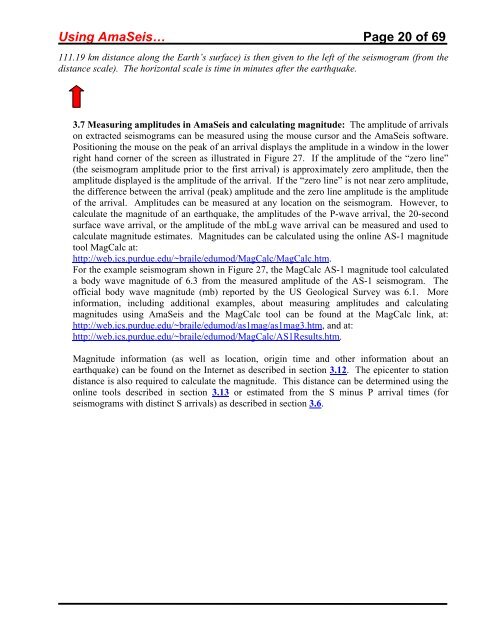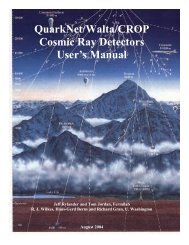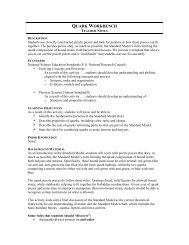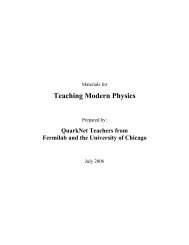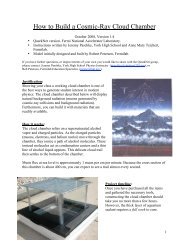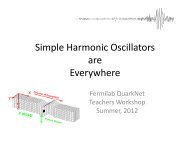Using the AmaSeis seismogram viewer and downloading - QuarkNet
Using the AmaSeis seismogram viewer and downloading - QuarkNet
Using the AmaSeis seismogram viewer and downloading - QuarkNet
Create successful ePaper yourself
Turn your PDF publications into a flip-book with our unique Google optimized e-Paper software.
<strong>Using</strong> <strong>AmaSeis</strong>… Page 20 of 69<br />
111.19 km distance along <strong>the</strong> Earth’s surface) is <strong>the</strong>n given to <strong>the</strong> left of <strong>the</strong> <strong>seismogram</strong> (from <strong>the</strong><br />
distance scale). The horizontal scale is time in minutes after <strong>the</strong> earthquake.<br />
3.7 Measuring amplitudes in <strong>AmaSeis</strong> <strong>and</strong> calculating magnitude: The amplitude of arrivals<br />
on extracted <strong>seismogram</strong>s can be measured using <strong>the</strong> mouse cursor <strong>and</strong> <strong>the</strong> <strong>AmaSeis</strong> software.<br />
Positioning <strong>the</strong> mouse on <strong>the</strong> peak of an arrival displays <strong>the</strong> amplitude in a window in <strong>the</strong> lower<br />
right h<strong>and</strong> corner of <strong>the</strong> screen as illustrated in Figure 27. If <strong>the</strong> amplitude of <strong>the</strong> “zero line”<br />
(<strong>the</strong> <strong>seismogram</strong> amplitude prior to <strong>the</strong> first arrival) is approximately zero amplitude, <strong>the</strong>n <strong>the</strong><br />
amplitude displayed is <strong>the</strong> amplitude of <strong>the</strong> arrival. If <strong>the</strong> “zero line” is not near zero amplitude,<br />
<strong>the</strong> difference between <strong>the</strong> arrival (peak) amplitude <strong>and</strong> <strong>the</strong> zero line amplitude is <strong>the</strong> amplitude<br />
of <strong>the</strong> arrival. Amplitudes can be measured at any location on <strong>the</strong> <strong>seismogram</strong>. However, to<br />
calculate <strong>the</strong> magnitude of an earthquake, <strong>the</strong> amplitudes of <strong>the</strong> P-wave arrival, <strong>the</strong> 20-second<br />
surface wave arrival, or <strong>the</strong> amplitude of <strong>the</strong> mbLg wave arrival can be measured <strong>and</strong> used to<br />
calculate magnitude estimates. Magnitudes can be calculated using <strong>the</strong> online AS-1 magnitude<br />
tool MagCalc at:<br />
http://web.ics.purdue.edu/~braile/edumod/MagCalc/MagCalc.htm.<br />
For <strong>the</strong> example <strong>seismogram</strong> shown in Figure 27, <strong>the</strong> MagCalc AS-1 magnitude tool calculated<br />
a body wave magnitude of 6.3 from <strong>the</strong> measured amplitude of <strong>the</strong> AS-1 <strong>seismogram</strong>. The<br />
official body wave magnitude (mb) reported by <strong>the</strong> US Geological Survey was 6.1. More<br />
information, including additional examples, about measuring amplitudes <strong>and</strong> calculating<br />
magnitudes using <strong>AmaSeis</strong> <strong>and</strong> <strong>the</strong> MagCalc tool can be found at <strong>the</strong> MagCalc link, at:<br />
http://web.ics.purdue.edu/~braile/edumod/as1mag/as1mag3.htm, <strong>and</strong> at:<br />
http://web.ics.purdue.edu/~braile/edumod/MagCalc/AS1Results.htm.<br />
Magnitude information (as well as location, origin time <strong>and</strong> o<strong>the</strong>r information about an<br />
earthquake) can be found on <strong>the</strong> Internet as described in section 3.12. The epicenter to station<br />
distance is also required to calculate <strong>the</strong> magnitude. This distance can be determined using <strong>the</strong><br />
online tools described in section 3.13 or estimated from <strong>the</strong> S minus P arrival times (for<br />
<strong>seismogram</strong>s with distinct S arrivals) as described in section 3.6.


